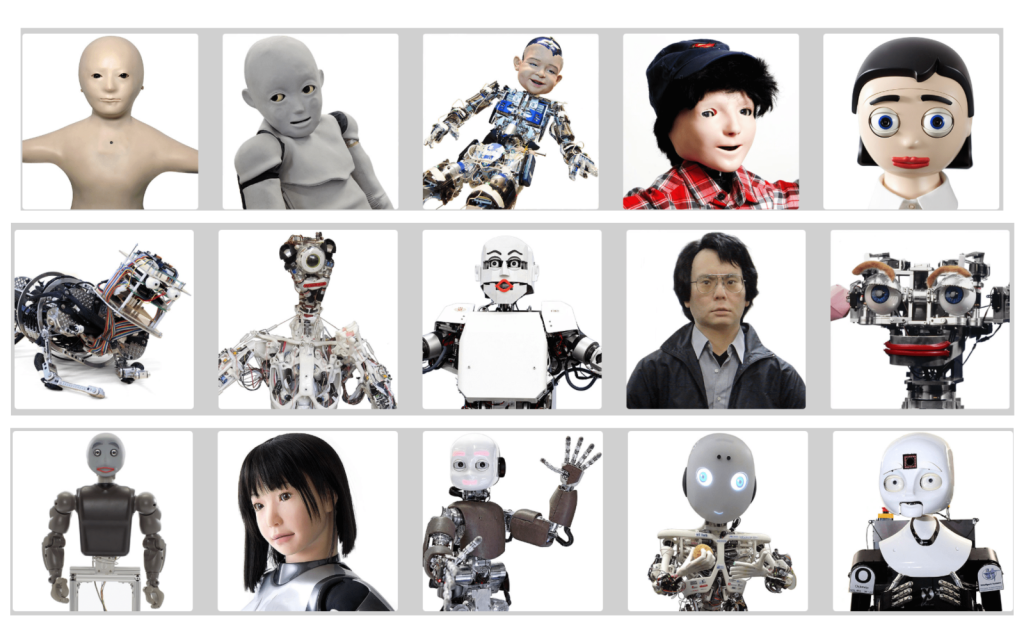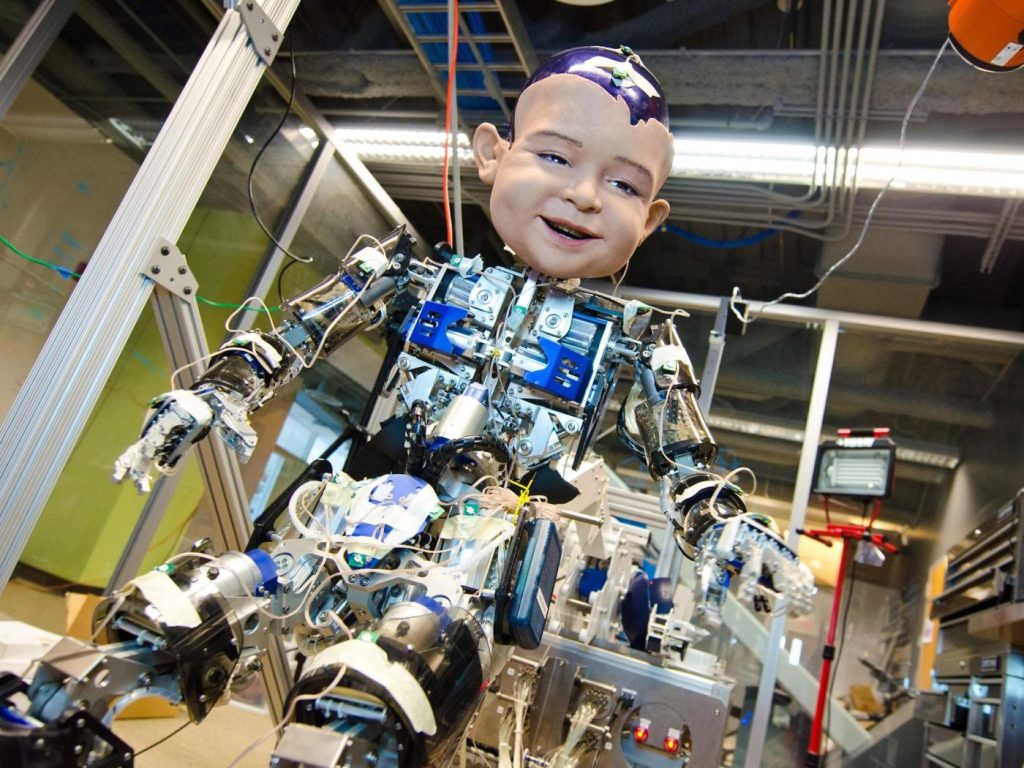In recent years, there has been a remarkable surge in research and development focused on virtual reality, photorealistic computer animations, and augmented reality. Scientists and engineers worldwide are actively engaged in these fields, pushing the boundaries of what’s possible in creating machines that possess human-like capabilities—or even humanoid robots.
This burgeoning area of study is becoming increasingly pivotal in the realm of robotics research. However, it’s important to consider the implications of the uncanny valley theory. It suggests that humanoid objects that closely resemble but fall short of being convincingly human can elicit unsettling or eerie responses from observers.

Top 7 Creepy Robots Ranked By IEEE
- TELENOID
Country: Japan
Creator: ATR
Year: 2010

Telenoid isn’t afraid of the dark.
Telenoid, the brainchild of researchers from Osaka University and Advanced Telecommunications Research Institute International (ATR), has earned the dubious honor of being crowned the creepiest robot by IEEE Spectrum. This portable teleoperated android is designed with a singular purpose: to seamlessly convey human presence.
Created with meticulous attention to detail, Telenoid stands out as a unique blend of innovation and eerie realism. Its design, inspired by human features, is carefully crafted to evoke a sense of familiarity while simultaneously unsettling observers. Despite its diminutive size and seemingly innocuous appearance, Telenoid possesses a powerful ability to transmit the essence of human presence.
This cutting-edge robot represents a significant leap forward in the realm of teleoperation, offering a compelling solution for bridging distances and facilitating remote interactions. Its inclusion in the list of the creepiest robots underscores the fascinating yet unsettling nature of human-robot interaction, prompting contemplation on the boundaries between artificial and organic entities.
- Diego-San
Country: United States
Creator: UC San Diego, Kokoro, and Hanson Robotics
Year: 2010

Diego-san is powered by pneumatic actuators.
Diego-San, a remarkable humanoid creation, marries the innovative prowess of Hanson Robotics and Japan’s Kokoro. This humanoid marvel is meticulously designed to mimic the appearance and behavior of a one-year-old baby, marking a significant stride in the realm of learning robots.
At its core lies a head crafted by Hanson Robotics, housing a sophisticated array of hardware that drives its remarkably expressive face. Complementing this intricate facial design is a body sculpted by Kokoro, seamlessly integrating form and function to bring Diego-San to life.
With its uncanny resemblance to a human infant, Diego-San serves as a captivating embodiment of artificial intelligence and robotics. Its ability to learn and interact with its surroundings underscores the potential for human-robot collaboration in various fields, from research and development to healthcare and education.
As a pioneering example of anthropomorphic robotics, Diego-San stands as a testament to the boundless possibilities of merging technology and creativity. Its existence prompts reflection on the nature of human cognition and the evolving relationship between man and machine in an increasingly automated world.
- Kaspar
Country: United Kingdom
Creator: University of Hertfordshire
Year: 2005
Kaspar, a child-sized humanoid robot, represents a groundbreaking fusion of technology and education. Renowned for its ability to exhibit a range of expressions, Kaspar’s face is adorned with a mask originally intended for CPR training mannequins. This innovative adaptation imbues Kaspar with a lifelike quality, enhancing its effectiveness as an educational tool.
Controlled by an external PC via USB or wirelessly through an onboard mini PC, Kaspar offers unparalleled versatility and ease of use. Its seamless integration with modern computing technology enables educators and researchers to interact with Kaspar effortlessly, unlocking a wealth of educational possibilities.
Beyond its technical capabilities, Kaspar serves as a testament to the transformative potential of robotics in education. By providing a lifelike and interactive learning experience, Kaspar enriches the educational landscape, fostering engagement and facilitating immersive learning environments. As society continues to embrace the potential of robotics in education, Kaspar stands at the forefront, exemplifying the innovative intersection of technology and pedagogy. Its presence heralds a new era of interactive and personalized learning experiences, promising to shape the future of education for generations to come.
- CB2
Country: Japan
Creator: Osaka University
Year: 2006

CB2 has cameras in its eyes and tactile sensors under its skin.
CB2 emerges as a groundbreaking child-robot, boasting a biomimetic body that blurs the boundaries between artificial intelligence and human emotion. Equipped with eye-cameras, CB2 possesses the remarkable ability to record emotional expressions, subsequently memorizing and correlating them with physical sensations. These intricate emotional profiles are then meticulously clustered on its circuit boards, facilitating a deeper understanding of human-like responses. The allure of CB2 lies not only in its advanced cognitive capabilities but also in its remarkably lifelike movements. From dangling its legs off a chair to synchronizing shoulder movements with rhythmic breathing, CB2 exudes a captivating sense of presence. Its piercing black eyes, equipped with sophisticated tracking technology, effortlessly follow movements across the room, adding to its aura of authenticity.
CB2’s integration of cutting-edge technology and biomimetic design represents a significant leap forward in the field of robotics. By seamlessly blending human-like expressions with advanced cognitive processing, CB2 offers a glimpse into the future of interactive robotics. As researchers continue to explore the potential applications of CB2, its impact on fields ranging from psychology and education to human-robot interaction promises to be profound.
- Flobi
Country: Germany
Creator: Bielefeld University
Year: 2009

Flobi is designed to look friendly to people.
Flobi emerges as a remarkable robotic creation, distinguished by its ability to convey a wide spectrum of human-like emotions, including shame, sadness, and happiness. What sets Flobi apart is its endearing cartoon-like appearance, which adds a touch of whimsy to its expressive capabilities.
The design of Flobi’s robotic head is a testament to innovation, featuring a seamless and “hole-free” construction that eliminates any visible conjunctions. This meticulous design ensures a smooth and aesthetically pleasing exterior, enhancing Flobi’s appeal as a lifelike companion.
With its ability to exhibit emotions in a relatable and engaging manner, Flobi transcends traditional notions of robotics. Its charming appearance and expressive range make it well-suited for a variety of applications, from interactive entertainment to therapeutic interventions.
As technology continues to evolve, Flobi stands as a shining example of the intersection between robotics and human emotion. Its seamless design and expressive capabilities pave the way for a new era of human-robot interaction, where companionship and empathy take center stage.
- Pneuborn
Country: Japan
Creator: Osaka University
Year: 2009

This robot baby is powered by air.
Pneuborn represents a groundbreaking advancement in robotics, specifically designed to simulate the development of musculoskeletal systems in infants. This innovative robotic infant simulator is equipped with the capability to autonomously learn fundamental movements such as crawling, sitting, and standing through the utilization of pattern generators and sophisticated learning algorithms.
Developed by researchers, Pneuborn serves as a pioneering platform to explore the intricate process of motion development in infants. By mimicking the biomechanics and motor control mechanisms observed in human infants, this robot offers invaluable insights into the complexities of early motor skill acquisition.
The significance of Pneuborn lies in its potential to revolutionize our understanding of motion development. Through empirical experimentation and data analysis facilitated by this robotic platform, researchers can delve deeper into the underlying principles governing infant motor development, paving the way for advancements in fields such as developmental psychology and robotics.
As Pneuborn continues to evolve and refine its capabilities, it holds the promise of unlocking new avenues of research and innovation in the study of human movement and cognition. By bridging the gap between robotics and developmental science, Pneuborn exemplifies the transformative power of interdisciplinary collaboration in pushing the boundaries of knowledge and discovery.
- ECCE
Country: France
Creator: The Robot Studio and ECCEROBOT Project
Year: 2009

ECCE (Embodied Cognition in a Compliantly Engineered Robot) stands as a pioneering humanoid robot, meticulously crafted to emulate the intricate mechanics of human movement. What sets ECCE apart is its utilization of artificial bones, muscles, and tendons, meticulously engineered to mimic the functionality of their biological counterparts. This innovative approach allows ECCE to move with the fluidity and grace characteristic of a human being.
One of the standout features of ECCE is its ability to engage in meaningful conversations over platforms like Skype. What makes this interaction truly remarkable is that the robot’s head direction and gestures are seamlessly controlled by a remote operator. This integration of remote control enables ECCE to convey nuanced expressions and engage in naturalistic communication, blurring the lines between human and robotic interaction.
By combining advanced robotics with embodied cognition principles, ECCE represents a significant step forward in the quest to create robots that not only move like humans but also interact with them in a lifelike manner. Its ability to hold conversations with remote control underscores the potential for robots to serve as effective communicative agents in various domains, from telepresence and education to healthcare and entertainment.
As ECCE continues to evolve and refine its capabilities, it holds the promise of revolutionizing our perception of robotics and human-robot interaction. By embodying the essence of cognition in a compliantly engineered form, ECCE opens doors to new possibilities in the realm of robotics and artificial intelligence.










Leave a Reply